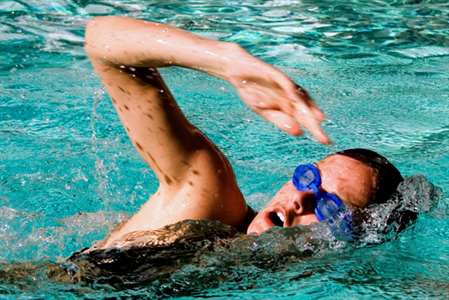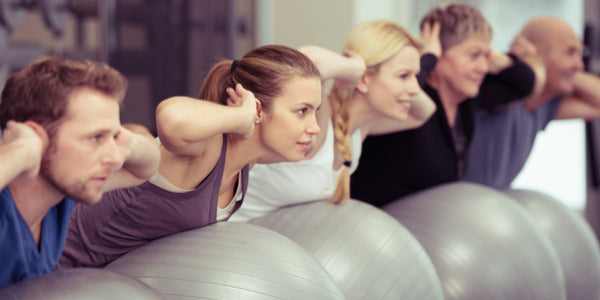
For many of us, swimming can be a leisurely activity, and the thought of turning it into a bun-busting workout may not sound spectacular.
Even though hanging out poolside may be relaxing and enjoyable, swimming for weight loss may not be such a bad idea if you are trying to lose a few inches around your waist.
“No other workout burns calories, boosts metabolism, and firms muscles better than swimming,” says Sean Wells, a certified Strength and Conditioning Specialist, and the fitness expert at BistroMD. “Swimming is great because it really works every muscle in your body without putting stress on your joints.”
So, if you want to get a sexy, summer shape, you don’t have to be an Olympic medalist to achieve your goal of a more sculpted physique. Our expert reveals ways you can make a splash in the pool while swimming your way to a healthier you this summer.
Bring on the Water Works
When you get ready to hit the water, there is no need to worry about swimming 50 laps at a time—it’s actually best to take an easier approach.
“A moderate swimming pace can burn up to 500 calories per hour,” says Sean. “Swimming is a perfect combination of burning calories and muscle recruitment, even at a less rigorous pace.”
Swimming for weight loss works because water is much denser than air. This is why each kick, push and pull is like a mini resistance workout for your body.
“Swimming is great for your core, and is also great for shaping your hips, arms, shoulders, and glutes,” says Sean. “In addition to burning calories as you swim, you are also building lean muscle.”
In addition to helping you build lean muscle and helping you burn those stubborn calories, swimming is also gentle on your body.
“The great thing about swimming is that you can swim almost every day without risking injury,” says Sean. “When you’re in the water, the amounts of gravitational forces on your body are reduced. This gives your joints the opportunity to take a break.”
Swimming for weight loss doesn’t just give you a great shape, but it can also make you feel up to 20 years younger!
“According to recent data presented by the American College of Sports Medicine Conference, habitual swimmers are up to 20 years younger than they are,” says Sean. “This is because their blood pressure, and cardiovascular performance are comparable to someone who is younger.”
Just take it easy the first few laps, and don’t over-push your lap-swimming abilities—you’re still burning calories, even at a less rigorous pace.
How to Start Your Swim
When people start a swimming workout, they often dive into the water head-first, with really high goals and expectations.
“If you want to start incorporating swimming into your workout, don’t dive in and expect to swim non-stop for 30 minutes or more,” says Sean. “This can actually work against you and make you feel defeated.”
Most people feel this defeat because they don’t realize that their muscles and cardiovascular system are required to work differently in the water than on land. This is why mixing up your swimming workout is crucial.
“In order to have an effective swimming workout, it’s important that you split your swim time into different segments at different intensities,” says Sean. “It’s also important that you take needed breaks.”
Start out by swimming four lengths of a pool at an easy effort—this means at a comfortable pace, with a few 30-second breaks. Repeat this for about 5-10 times. Try this for two to three times during the week, and gradually intensify your sessions from there. Once you master your routine, try to make this a weekly habit.
Different Strokes for Different Folks
When stroking through the pool to burn those calories, it’s best to mix things up and not to free-style all of the time.
“Using different strokes and techniques while swimming can help beat boredom and help balance your muscles,” says Sean. “Two strokes to try at first are the backstroke and breaststroke.”
In order to get the most out of these swimming techniques, follow this advice from Sean below:
1. The Backstroke
“To utilize the backstroke, make sure your eyes are up, and that you are looking straight up at the sky or ceiling,” says Sean. “Reach back with each arm at a 45 degree angle. This places less stress on your shoulders and makes your stoke more efficient.”
2. The Breaststroke
“When doing the breaststroke, it’s important that you reach your arms overhead, and keep your palms together,” says Sean.
You should always bring your hands inward by your chest when you sweep through, then reach out again.
“Also remember to keep your toes outward and kick your legs back and together—like a frog—as you extend your arms forward,” says Sean.
Position Your Body for Success
“When utilizing different techniques while swimming, it’s important that you know how to place the different parts of your body most effectively,” says Sean.
Here are some more tips on how to position the other parts of your body most effectively in the water.
Your Elbows: Should always be higher than your wrist
Your Hands: Always pull them through the water, and keep your fingers pointed at the bottom of the pool. It’s also important that you avoid cupping your hands.
Your Head and Shoulders: Make sure your head and neck are aligned with your spine, and keep your shoulders relaxed.
Your Feet: Keep them close together and in line with the rest of your body.
Your Hips: Pivot your hips 45 degrees with each stroke. Rotating your hips will give you great results.
Your Triceps: Finish each stroke with your arm fully extended behind you.
Your Mouth: As you rotate your body to the side to breathe, rotate your head, but don’t lift it out of the water. Take a breath through your mouth, and exhale gently under the water until it’s time to take in more air.







